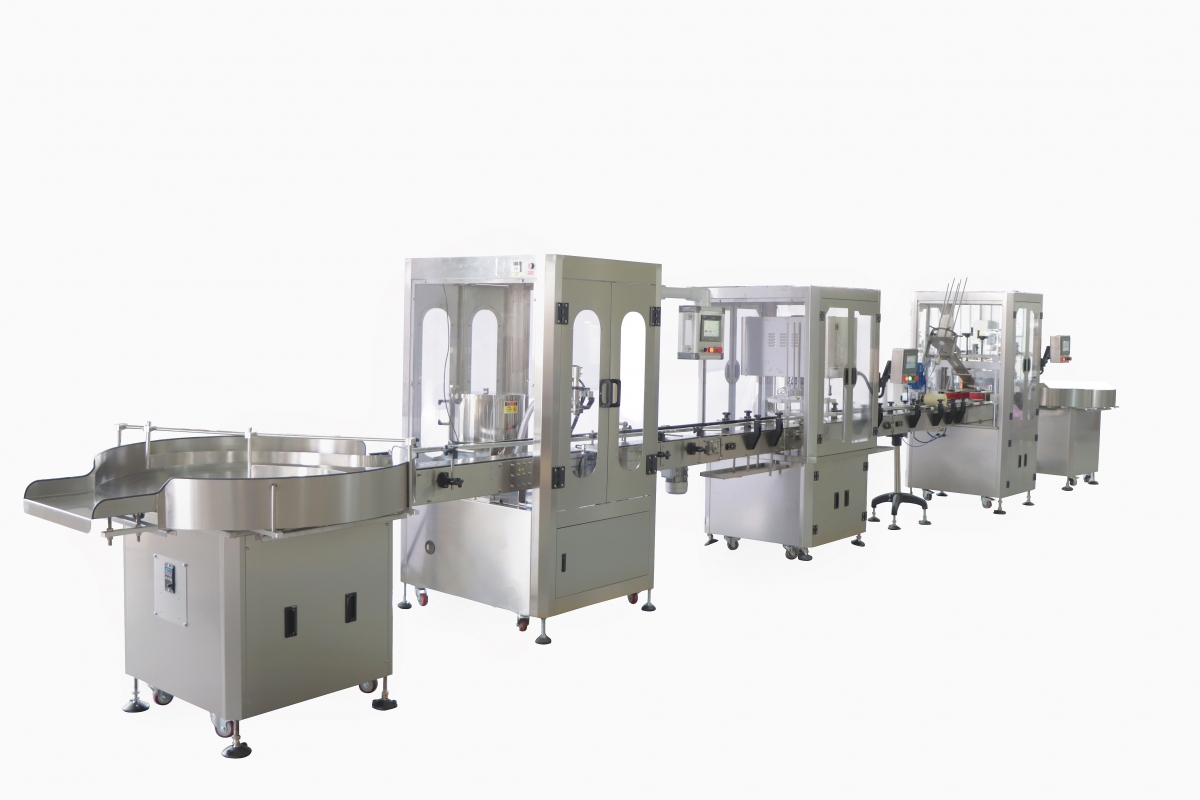- 18
- Dec
ນ້ຳມັນທະເລສາ ມາດບັນຈຸເສັ້ນ
ຜົນປະໂຫຍດຂອງການນໍາໃຊ້ນ້ໍາມັນງາສາມາດບັນຈຸເສັ້ນ
ວິທີເລືອກເສັ້ນບັນຈຸນ້ຳມັນງາທີ່ເໝາະສົມສຳລັບທຸລະກິດຂອງທ່ານ
ແນວໂນ້ມດ້ານເທັກໂນໂລຢີຂອງນ້ຳມັນງາສາມາດບັນຈຸພັນໄດ້
ນ້ຳມັນງາໄດ້ເປັນອາຫານຫຼັກໃນອາຫານຫຼາຍສັດຕະວັດແລ້ວ, ໄດ້ຮັບລາງວັນຈາກລົດຊາດທີ່ເປັນເອກະລັກ ແລະ ຜົນປະໂຫຍດຕໍ່ສຸຂະພາບ. ໃນຂະນະທີ່ຄວາມຕ້ອງການນ້ໍາມັນງາຍັງສືບຕໍ່ເຕີບໂຕ, ຜູ້ຜະລິດກໍາລັງຊອກຫາວິທີການປັບປຸງຂະບວນການຫຸ້ມຫໍ່ຂອງພວກເຂົາຢ່າງຕໍ່ເນື່ອງເພື່ອຕອບສະຫນອງຄວາມຕ້ອງການຂອງຜູ້ບໍລິໂພກແລະແຂ່ງຂັນໃນຕະຫຼາດ. ຫນຶ່ງໃນທ່າອ່ຽງທາງດ້ານເທກໂນໂລຍີການຫຸ້ມຫໍ່ນ້ໍາມັນຫມາກງາແມ່ນການນໍາໃຊ້ລະບົບອັດຕະໂນມັດເພື່ອເພີ່ມປະສິດຕິພາບແລະຫຼຸດຜ່ອນຄ່າໃຊ້ຈ່າຍ.
ອັດຕະໂນມັດໄດ້ປະຕິວັດວິທີການບັນຈຸນ້ໍາມັນຫມາກງາ, ຜະນຶກເຂົ້າກັນ, ແລະຕິດສະຫຼາກ. ໂດຍການນໍາໃຊ້ແຂນແລະເຊັນເຊີຫຸ່ນຍົນ, ຜູ້ຜະລິດສາມາດຮັບປະກັນວ່າແຕ່ລະກະປ໋ອງຖືກຕື່ມໃສ່ໃນລະດັບທີ່ຖືກຕ້ອງ, ຜະນຶກເຂົ້າກັນຢ່າງແຫນ້ນຫນາເພື່ອປ້ອງກັນການຮົ່ວໄຫຼ, ແລະຕິດສະຫຼາກຢ່າງຖືກຕ້ອງດ້ວຍຂໍ້ມູນທີ່ຈໍາເປັນທັງຫມົດ. ນີ້ບໍ່ພຽງແຕ່ເລັ່ງຂະບວນການຫຸ້ມຫໍ່, ແຕ່ຍັງຫຼຸດຜ່ອນຄວາມສ່ຽງຕໍ່ຄວາມຜິດພາດຂອງມະນຸດ, ຮັບປະກັນຜະລິດຕະພັນທີ່ສອດຄ່ອງແລະມີຄຸນນະພາບສູງທຸກຄັ້ງ.
ແນວໂນ້ມອື່ນໃນນ້ໍາຫມາກງາສາມາດບັນຈຸພັນເຕັກໂນໂລຊີແມ່ນການນໍາໃຊ້ວັດສະດຸແລະຂະບວນການເປັນມິດກັບສິ່ງແວດລ້ອມ. ເມື່ອຜູ້ບໍລິໂພກມີສະຕິຕໍ່ສິ່ງແວດລ້ອມຫຼາຍຂຶ້ນ, ຜູ້ຜະລິດກໍ່ຖືກກົດດັນໃຫ້ຫຼຸດການປ່ອຍກາກບອນ ແລະ ຫຼຸດຜ່ອນສິ່ງເສດເຫຼືອ. ວິທີໜຶ່ງທີ່ເຂົາເຈົ້າກຳລັງເຮັດຄື ການນຳໃຊ້ວັດສະດຸທີ່ນຳມາໃຊ້ຄືນໃໝ່ໄດ້ສຳລັບກະປ໋ອງ ແລະ ການຫຸ້ມຫໍ່, ພ້ອມທັງການຈັດຕັ້ງປະຕິບັດລະບົບການປະຢັດພະລັງງານເພື່ອຫຼຸດຜ່ອນຜົນກະທົບໂດຍລວມຕໍ່ສິ່ງແວດລ້ອມ.
ນອກຈາກລະບົບອັດຕະໂນມັດ ແລະ ຄວາມຍືນຍົງແລ້ວ, ຜູ້ຜະລິດຍັງສຸມໃສ່ການປັບປຸງເຄື່ອງໃຊ້ໄຟຟ້າ. ຄວາມປອດໄພແລະສຸຂະອະນາໄມຂອງສາຍການຫຸ້ມຫໍ່ຂອງເຂົາເຈົ້າ. ດ້ວຍກົດລະບຽບທີ່ເຂັ້ມງວດເພື່ອຮັບປະກັນຄວາມປອດໄພຂອງອາຫານ, ມັນເປັນສິ່ງ ສຳ ຄັນທີ່ຜູ້ຜະລິດຕ້ອງຮັກສາສະພາບແວດລ້ອມການຜະລິດທີ່ສະອາດແລະສຸຂາພິບານ. ນີ້ລວມມີການທໍາຄວາມສະອາດແລະບໍາລຸງຮັກສາອຸປະກອນເປັນປົກກະຕິ, ເຊັ່ນດຽວກັນກັບການປະຕິບັດມາດຕະການປ້ອງກັນການປົນເປື້ອນໃນລະຫວ່າງຂະບວນການຫຸ້ມຫໍ່.
ຫນຶ່ງໃນສິ່ງທ້າທາຍທີ່ສໍາຄັນໃນນ້ໍາຫມາກງາສາມາດເຕັກໂນໂລຊີການຫຸ້ມຫໍ່ແມ່ນຮັບປະກັນວ່າຜະລິດຕະພັນຍັງຄົງສົດແລະມີລົດຊາດຕະຫຼອດຊີວິດການເກັບຮັກສາຂອງມັນ. ເພື່ອແກ້ໄຂບັນຫານີ້, ຜູ້ຜະລິດກໍາລັງລົງທຶນໃນວັດສະດຸຫຸ້ມຫໍ່ທີ່ກ້າວຫນ້າແລະເຕັກນິກທີ່ຊ່ວຍຮັກສາຄຸນນະພາບຂອງນ້ໍາມັນ. ນີ້ລວມເຖິງການໃຊ້ແຜ່ນປ້ອງກັນອົກຊີເຈນເພື່ອປ້ອງກັນການເກີດຜຸພັງ, ລວມທັງການລວມເອົາສານເຄືອບທີ່ທົນທານຕໍ່ UV ເພື່ອປ້ອງກັນນໍ້າມັນຈາກການຖືກແສງ.
ເນື່ອງຈາກຄວາມມັກຂອງຜູ້ບໍລິໂພກຍັງສືບຕໍ່ພັດທະນາ, ຜູ້ຜະລິດຍັງຊອກຫາວິທີໃຫມ່ເພື່ອຈໍາແນກຜະລິດຕະພັນຂອງເຂົາເຈົ້າໂດຍຜ່ານການອອກແບບການຫຸ້ມຫໍ່ນະວັດກໍາ. ນີ້ລວມມີການໃຊ້ສີສັນສົດໃສ ແລະກາຟິກທີ່ຈັບຕາເພື່ອດຶງດູດຄວາມສົນໃຈໃນຊັ້ນວາງ, ເຊັ່ນດຽວກັນກັບການລວມເອົາອົງປະກອບການໂຕ້ຕອບເຊັ່ນລະຫັດ QR ຫຼືຄຸນສົມບັດຄວາມເປັນຈິງທີ່ເພີ່ມຂຶ້ນເພື່ອດຶງດູດຜູ້ບໍລິໂພກ ແລະໃຫ້ຂໍ້ມູນເພີ່ມເຕີມກ່ຽວກັບຜະລິດຕະພັນ.
ໂດຍລວມແລ້ວ, ທ່າອ່ຽງດ້ານເຕັກໂນໂລຊີການບັນຈຸນ້ຳໝາກງາແມ່ນສຸມໃສ່ການປັບປຸງປະສິດທິພາບ, ຄວາມຍືນຍົງ, ຄວາມປອດໄພ, ແລະ ຄຸນນະພາບຜະລິດຕະພັນ. ໂດຍການຍອມຮັບອັດຕະໂນມັດ, ການປະຕິບັດທີ່ເປັນມິດກັບສິ່ງແວດລ້ອມ, ແລະການອອກແບບນະວັດກໍາ, ຜູ້ຜະລິດສາມາດຢູ່ຂ້າງຫນ້າຂອງການແຂ່ງຂັນແລະຕອບສະຫນອງຄວາມຕ້ອງການຂອງຜູ້ບໍລິໂພກທີ່ມີການປ່ຽນແປງ. ໃນຂະນະທີ່ເຕັກໂນໂລຢີສືບຕໍ່ກ້າວຫນ້າ, ພວກເຮົາສາມາດຄາດຫວັງວ່າຈະເຫັນການພັດທະນາທີ່ຫນ້າຕື່ນເຕັ້ນຫຼາຍກວ່າເກົ່າໃນເຕັກໂນໂລຢີເສັ້ນການຫຸ້ມຫໍ່ນ້ໍາມັນຫມາກງາໃນຊຸມປີຂ້າງຫນ້າ.
Sesame oil has been a staple in many cuisines for centuries, prized for its unique flavor and health benefits. As the demand for sesame oil continues to grow, manufacturers are constantly looking for ways to improve their packaging processes to meet consumer needs and stay competitive in the market. One of the top trends in sesame oil can packaging line technology is the use of automated systems to increase efficiency and reduce costs.
Automation has revolutionized the way sesame oil cans are filled, sealed, and labeled. By using robotic arms and sensors, manufacturers can ensure that each can is filled to the correct level, sealed tightly to prevent leaks, and labeled accurately with all the necessary information. This not only speeds up the packaging process but also reduces the risk of human error, ensuring a consistent and high-quality product every time.
Another trend in sesame oil can packaging line technology is the use of eco-friendly materials and processes. With consumers becoming more environmentally conscious, manufacturers are under pressure to reduce their carbon footprint and minimize waste. One way they are doing this is by using recyclable materials for their cans and packaging, as well as implementing energy-efficient systems to reduce their overall impact on the environment.
In addition to automation and sustainability, manufacturers are also focusing on improving the safety and hygiene of their packaging lines. With strict regulations in place to ensure food safety, it is crucial for manufacturers to maintain a clean and sanitary production environment. This includes regular cleaning and maintenance of equipment, as well as implementing measures to prevent contamination during the packaging process.
One of the key challenges in sesame oil can packaging line technology is ensuring that the product remains fresh and flavorful throughout its shelf life. To address this issue, manufacturers are investing in advanced packaging materials and techniques that help preserve the quality of the oil. This includes using oxygen barrier films to prevent oxidation, as well as incorporating UV-resistant coatings to protect the oil from light exposure.
As consumer preferences continue to evolve, manufacturers are also exploring new ways to differentiate their products through innovative packaging designs. This includes using vibrant colors and eye-catching graphics to attract attention on the shelf, as well as incorporating interactive elements such as QR codes or augmented reality features to engage consumers and provide additional information about the product.

Overall, the top trends in sesame oil can packaging line technology are focused on improving efficiency, sustainability, safety, and product quality. By embracing automation, eco-friendly practices, and innovative design, manufacturers can stay ahead of the competition and meet the changing needs of consumers. As technology continues to advance, we can expect to see even more exciting developments in sesame oil can packaging line technology in the years to come.
